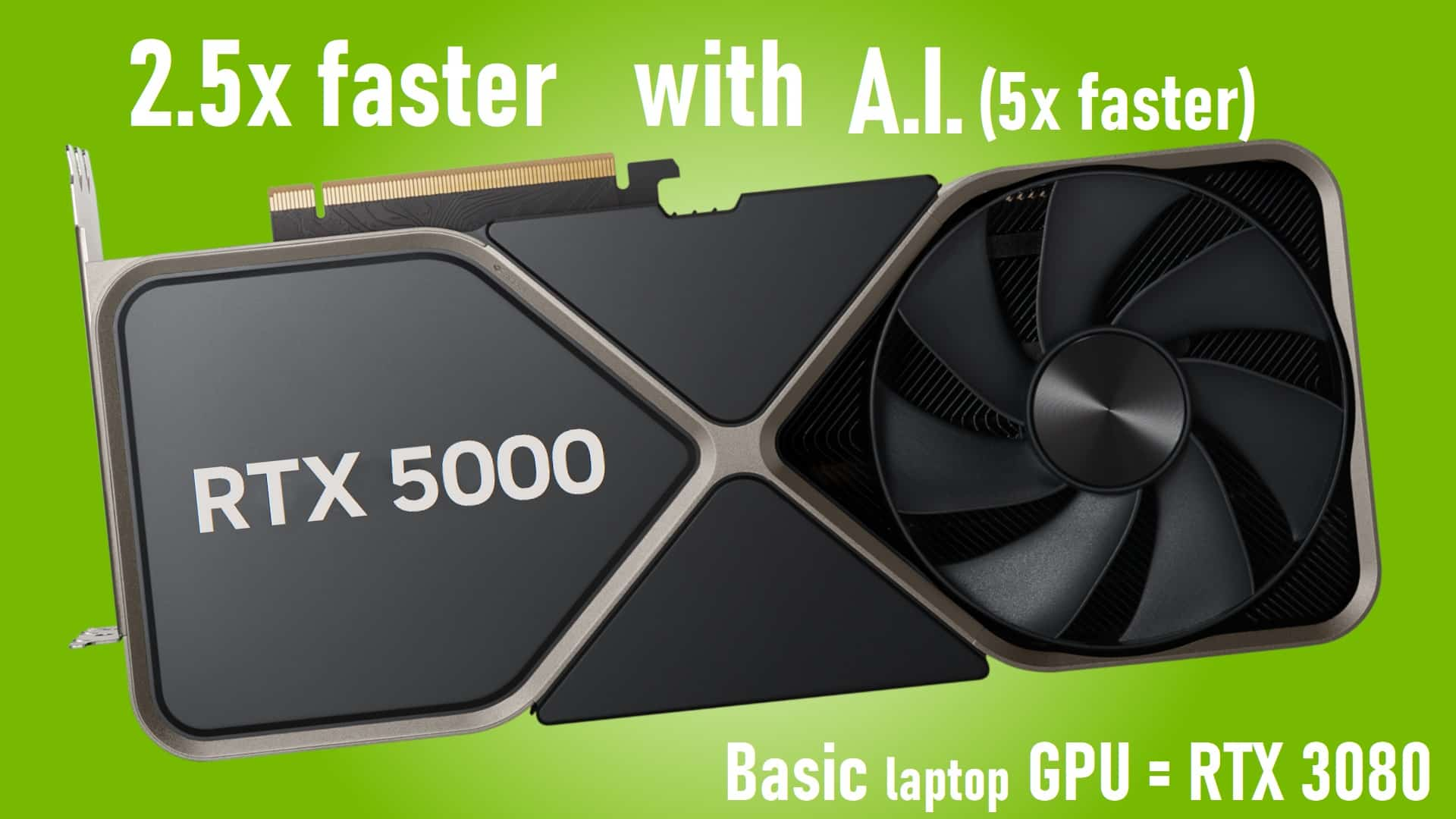Nvidia’s upcoming RTX 50-series graphics cards are slated to bring major performance improvements through advancements in ray tracing, AI processing, and general rasterization capabilities. The new cards will utilize TSMC’s cutting-edge 3nm manufacturing process and introduce new GPU architectures to push visuals and frame rates to the next level.
However, as with any unreleased hardware, there are still many unknowns and speculation around exactly how much faster the RTX 50-series will be over current RTX 40-series cards. In this comprehensive deep dive, we’ll analyze the potential performance gains, expected features, pricing, and overall value proposition of Nvidia’s next generation of GPUs.
Projected Performance Improvements
Nvidia is touting massive performance claims for its future RTX 5090 flagship, stating it could deliver up to 2-2.5x better performance versus the RTX 4090. However, these lofty projections likely refer to theoretical compute workloads rather than actual gameplay scenarios.
Looking at historical generational performance gains provides more realistic insight:
- RTX 3090 -> RTX 4090: 1.7x performance uplift
- RTX 2080 Ti -> RTX 3090: 1.7x performance uplift
Given these precedents, a 40-60% generational performance improvement seems more plausible for the RTX 5090 over the 4090 in games. Still an impressive leap, but not the exaggerated 2-2.5x claims.
Expected Performance Gains of RTX 5090
| Performance Area | Expected Gain |
|---|---|
| Ray Tracing | 2-2.5x |
| AI Processing | 2-2.5x |
| Rasterization (gaming) | 40-60% |
With embellished marketing aside, Nvidia has several promising technologies in the pipeline that could enable the projected 40-60% gaming performance uplift:
- TSMC 3nm process – 10-15% increased efficiency over 5nm
- Faster GDDR7 memory – Up to 36Gbps speed versus 21Gbps in RTX 40-series
- Architecture improvements – Redesign for efficiency and IPC gains
- Higher core counts – More CUDA and RT cores
- Faster clock speeds – Potentially over 3GHz
Combining these advancements gives Nvidia multiple avenues to extract greater performance from next-gen RTX GPUs. But the efficiency gains from TSMC 3nm alone likely won’t push gaming performance over 30%.
Nvidia will need to leverage all of these improvements in tandem to hit the 40-60% target – no simple feat but achievable with proper execution and binning of the top GPUs for the RTX 5090.
Ray Tracing and AI Performance
While gaming frame rates will see a moderate generational boost, ray tracing and AI workloads are where Nvidia is targeting huge performance gains upwards of 2-2.5x.
These specialized workloads better take advantage of the increased transistor density and power efficiency of TSMC’s 3nm process. Nvidia is also actively developing enhanced RT cores and Tensor cores to accelerate ray tracing and deep learning performance.
Expect the RTX 5090 to deliver significantly smoother ray traced visuals and lightning fast AI processing compared to current GPUs:
- Up to 2.5x faster ray tracing performance
- Up to 2.5x faster deep learning and neural net processing
This will provide a more transformational leap for content creation and productivity applications tapping into RT and AI. Gaming ray tracing should also improve substantially, but current performance limitations indicate the 2-2.5x gains may be difficult to reach in actual gameplay. Still, strong progress is expected.
Architectural Improvements
Alongside silicon advancements, Nvidia is working on major architectural changes for its RTX 50-series GPUs according to leaks. The company introduced the Ampere architecture with its RTX 30-series, followed by more iterative upgrades in Ada Lovelace powering the RTX 40-series.
Reports indicate Nvidia engineers have gone back to the drawing board for a more impactful architectural overhaul tentatively named “Blackwell”. The goals of this new architecture include:
- Improving performance per watt
- Increasing instruction per clock (IPC)
- Boosting ray tracing and AI efficiencies
- Streamlining data flows and memory access
Combined with the TSMC 3nm process, Nvidia’s next-gen architecture could drive significant performance uplifts if these efficiency goals are realized. Blackwell may position the RTX 50-series as one of Nvidia’s most impactful GPU architecture changes in years.
Faster Memory: GDDR7
To feed its next-gen GPUs, Nvidia will equip RTX 50-series cards with cutting-edge GDDR7 memory developed by partners Samsung and SK Hynix.
GDDR7 promises to raise memory bandwidth substantially:
- Up to 36Gbps speed
- 60% faster vs. 21Gbps GDDR6X
- Double the bandwidth vs. GDDR6
This additional memory throughput will alleviate bottlenecks and improve gaming performance. Nvidia has doubled memory capacity each generation, so expect 24GB as the new baseline for xx50 cards, 48GB on xx70 models and 96GB or more on the flagship RTX 5090.
What About Pricing?
Unsurprisingly, rumors indicate Nvidia will raise prices again with its RTX 50-series lineup based on the ‘ultra-premium’ branding. The RTX 4090 already costs a staggering $1600, so don’t expect the 5090 to be cheap. Here are rough estimates for next-gen pricing:
- RTX 5090 – $1700-$2000
- RTX 5080 16GB – $1200
- RTX 5070 – $800
- RTX 5060 – $500
As before, expect the mid-range RTX 5070 and 5060 to offer mediocre value compared to the halo 5090. This trend caters to Nvidia’s datacenter and AI businesses where profit margins are much higher than consumer graphics.
Performance Per Dollar Outlook
To summarize the gaming performance expectations:
- RTX 5090 will deliver 40-60% higher frame rates for ~20% increased cost over the RTX 4090
- RTX 5070 and 5060 will provide minor 10-15% performance gains over RTX 4070 and 4060 equivalents
Given the expected pricing, performance per dollar is not likely to improve substantially. The RTX 5090 will certainly claim the performance crown, but its ~$2000 price tag restricts it to ultra-enthusiasts. For mainstream gamers, the RTX 40-series currently provides the best mix of pricing and performance.
Of course, this can change depending on competitive pressure from AMD’s next-gen RDNA 3 GPUs coming later in 2023. But based on historical trends, don’t expect great value from Nvidia’s 50-series pricing. The Taiwan Semiconductor Manufacturing Company’s coveted 3nm FinFET process promises to raise transistor density by 70% and boost performance by 10-15% over the 5nm process that the RTX 40-series is built on. This gives Nvidia an immediate performance uplift for its RTX 50-series GPUs.
When combined with faster GDDR7 memory, more advanced architectures, and higher core counts, the RTX 5090 in particular is shaping up to be an absolute performance beast – albeit at an expected eye-watering price over $2000. For mainstream gamers, the current RTX 40-series still offers the best blend of performance and value. But the 50-series will push enthusiast gaming visuals and frame rates further than ever before.
UPDATE
Nvidia RTX 50 Series GPU Rumors – Massive Performance Gains Incoming?
Exciting rumors are surfacing about Nvidia’s future RTX 50 series graphics cards. Leaked information suggests the RTX 5090 and 5080 could deliver enormous generational performance gains when they launch in 2024 or 2025. Let’s break down the leaks and analyze how much faster the RTX 50 series might be compared to today’s RTX 40 GPUs.
RTX 50 Series to Use Cutting-Edge TSMC 3nm Process
Most reports indicate the flagship RTX 5090 will leverage TSMC’s next-gen 3nm manufacturing process. This node shift alone should bring significant improvements.
Benefits of 3nm:
- 70% higher transistor density vs. 5nm
- 15% faster speeds due to reduced capacitance
- Lower power consumption
3nm will allow Nvidia to pack more cores and memory into a smaller die area. And clock speeds can increase thanks to the power optimizations.
Higher-end RTX 50 series cards will likely use 3nm, while cheaper models may stick with 5nm. But the top-tier parts like the RTX 5090 will take full advantage of 3nm.
Massive Die Size and Core Count Rumored
Credible leaks point to the RTX 5090 utilizing a 620mm2 die. Compare this to the RTX 4090’s 608mm2 die on 4nm. With the extreme density improvements of 3nm, a die this large could allow for some incredible specs:
Potential RTX 5090 core configuration:
- Up to 31,744 CUDA cores (RTX 4090 has 16,384 cores)
- Up to 248 SMs (RTX 4090 has 128 SMs)
A nearly 100% increase in the number of streaming multiprocessors and CUDA cores would translate to enormous performance gains. Even if Nvidia scales back the full configuration, we should still see at least a 70-80% uplift over the 4090.
Estimated Clock Speeds Also Point to a Major Boost
The RTX 5090 is rumored to hit GPU boost clocks around 3 GHz. The RTX 4090 tops out at 2.52 GHz. This 18% higher clock speed further compounds the performance benefits.
With more cores running at higher frequencies, the 5090 could achieve up to 2.3X the raw shader/compute performance of the 4090 (190 TFLOPs vs 83 TFLOPs).
Faster Memory and More Memory Bandwidth
Nvidia should equip next-gen cards with cutting-edge GDDR7 memory delivering up to 24 Gbps speeds. Combined with a wider 384-bit or 512-bit bus, overall memory bandwidth could rise significantly:
- 5090 with 384-bit bus = 1.5 TB/s
- 5090 with 512-bit bus = 2 TB/s
- 4090 has 1 TB/s with 384-bit bus
The 5090 looks set to deliver up to 2X the memory bandwidth. This feeds the extra cores and maintains high performance at 4K and 8K resolutions.
Higher capacity GDDR7 chips would also enable 24GB or even 48GB of VRAM on flagship models.
Summary of RTX 5090 Leaks
If rumors hold true, the RTX 5090 will be an absolute performance monster:
- Up to 2.5X more CUDA cores
- 18% higher clock speeds
- 2X the memory bandwidth
- Extra VRAM capacity
- Built on an advanced 3nm process
Add this all up and Nvidia could achieve up to 2.5X the performance of the already super-powerful RTX 4090.
When Will the RTX 50 Series Arrive?
Most rumors point to an early 2025 launch window for the RTX 50 series. However, recent reports indicate manufacturing could kick off by early 2024, so a late 2024 release is possible for high-end parts like the RTX 5090.
The Next Titan?
Some leaks suggest an even more extreme 512-bit bus RTX 50 series card for 8K gaming. This “Titan” model would likely carry an insane price tag north of $2000. But it would cement the 50 series as the new benchmark for enthusiast PC gaming performance.
Conclusion
It’s an exciting time for PC gamers and hardware enthusiasts! Nvidia’s next-generation RTX 50 GPU family looks poised to deliver enormous performance gains that could vastly exceed the already impressive leap we saw from the 3000 series to the 4000 series.
Of course, leaks should always be taken with a grain of salt. But the early rumors paint an enticing picture of just how powerful our graphics cards could become by 2025. I can’t wait to see reviews of the first RTX 50 series GPUs when they inevitably arrive in the next couple years.













